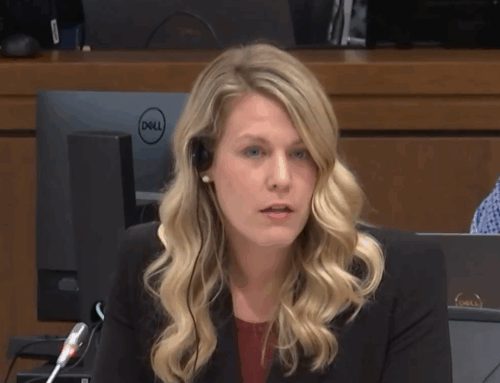Paul Tuns
Editor’s Note: Part I appeared in the November edition of The Interim and is available here.
 Pro-life leaders generally agree that the movement must do a better job reaching beyond its current scope of organizational supporters, although there is not as much agreement about how to do that.
Pro-life leaders generally agree that the movement must do a better job reaching beyond its current scope of organizational supporters, although there is not as much agreement about how to do that.
Jakki Jeffs, executive director of Alliance for Life Ontario, told The Interim that she would like to see the pro-life movement come together and strategize how to better reach beyond the existing audience to get more of the general public to think about abortion and take action against it. She said that pro-life leaders should think about presenting a united pro-life message, discuss ways to get that message to a broader audience, and get more people who hold pro-life views more active based on their values.
Jeffs said that disunity within the pro-life movement — “we end up arguing or disagreeing with each other rather than addressing one of the most pressing tragedies of our times together” — prevents it from getting “on the same page to develop a strategy” to reach out beyond our own circles to get the broader public to care about “300 babies killed by abortion every day in Canada and many of their mothers either physically, emotionally, mentally or psychologically damaged.”
Timidity on the part of the pro-life movement is part of the problem, Jeffs said. “At the moment I believe that politicians rather than the pro-life movement” are calling the shots, because “we are being told what they are prepared to present rather than [we] sitting down to discuss what we believe it is important to address.” Jeffs said, “what is possible should not be a criterion for what we plan – but what is the right thing to do – given our mission.”
For years, social media has been mentioned as one way to reach a larger audience but increasingly we see that Facebook, Twitter, Instagram and other social media platforms allow for people to curate their news to block out viewpoints with which they disagree. The upside is that it is easier for pro-lifers to find pro-life material, but not as likely to be seen by people who are pro-abortion or do not have any strong views one way or another.
Patricia Maloney, who blogs at Run with Life, said she does not use social media, other than her blog, because, “It is really just an echo chamber with no real engagement … I find it a waste of time.”
Jeffs has her doubts about the utility of social media to reach outside the pro-life bubble. She noted that even if pro-life groups could get traction outside the movement, the technology companies that run social media censor pro-life content. She said, “Possibly we need to go back to some very simple means of communicating our message – writing on sidewalks, painting on walls, developing pro-life graffiti, having pro-life messages in our snail mail, developing pro-life drawing books, writing short stories.”
Pete Baklinski, director of communications for Campaign Life Coalition, said, “Social media is largely a toxic environment that often brings out the worst in people” but, “still, it has been effectively used by many individuals to get out the pro-life message and to educate countless people.” He said that pro-life leaders such as Abby Johnson, Lila Rose and Fr. Frank Pavone have hundreds of thousands of followers who share their content, further spreading pro-life information to their family, friends, and colleagues. “The cumulative effect of users sharing such messages can be massive.” He warned pro-lifers to not eschew strategies that can exploit the possibility of viral messaging online.
Laura Klassen, founder of Choice42 (Choice for Two), said social media “has been great in terms of giving us a platform when we have no chance with the mainstream media,” but she also recognizes its shortcomings, namely the threat of censorship. She said Choice42 has “managed to adapt by creating content like our pink-haired satire videos which passes as pro-abortion content at first glance.” She also said that Choice42 has been able to reach abortion-minded women online and convinced them not to go through with killing their baby by providing assistance to them.
Blaise Alleyne, eastern outreach director of the Canadian Centre for Bioethical Reform and founder of Toronto Against Abortion, said social media can help the movement reach “audiences that we might not otherwise be able to reach,” but, “it’s a huge obstacle for changing hearts and minds on abortion.” He said it is challenging because “We have to start from the goal and work backwards” — how do we reach “people who would rather not think about abortion.” He said that most people online “inhabit a tightly filtered bubble of their own so they only see and pay attention to the kind of content they want to see.”
Alleyne said that it is difficult to get abortion victim photography past the tech censors and thus social media is not a great platform to persuade people to change their minds about abortion.
That does not mean that pro-life groups abandon Twitter, Facebook and other platforms. Alleyne said “we want to be present when people are talking about abortion, so that we can bring science, human rights and discussion about the violence of abortion into the dialogue.”
But the social media bubble might have benefits, too. Alleyne said pro-life groups should remain active online because it helps existing pro-lifers become more involved with in-person activism. Both Toronto Against Abortion and Campaign Life Coalition report that engaging with like-minded people online has turned online activists into real-life activists with many raising the issue in their spheres of influence or becoming active in various forms of pro-life witnessing.
Alleyne said online efforts “are primarily useful for reaching other pro-lifers, who want to see pro-life content, and using that as an opportunity not just to preach to the choir but to inspire them to get involved in projects offline that will reach the public directly.”
Street activism is one way to bring the pro-life message directly to people, although the enactment of provincial anti-speech bubble zones prohibiting pro-life witnessing near abortion facilities can make that more difficult. Maloney said the bubble zone in Ontario has diminished the utility of 40 Days for Life near the Ottawa abortuary, but that LifeChain is quite visible.
Baklinski said CLC appreciates the work done by all pro-life groups “working for an abortion-free Canada” by “showing what abortion looks like” with the use of abortion-victim photography through billboards, posters, and pamphlets — groups such the Canadian Centre for Bioethical Reform, and Toronto Against Abortion, as well as CLC Youth-organized Choice Chains.
Jeffs said that pro-life demonstrations such as LifeChain and 40 Days for Life are worthwhile efforts because it puts the pro-life message “in the public square.” She would like to see more demonstrations and Alliance for Life has promoted the concept of an annual LightChain that has lit-up numbers representing the abortion death toll. Where it has been tried, Jeffs reports, “The conversation is quite amazing, citizens look at the numbers and ask what they are, and it goes from there.” Another initiative they are considering for 2022 is a Day of Tears based on the U.S. program, in which churches, schools, community organizations, and city hall to fly flags at half mast to commemorate the lives lost to abortion. It would be another visible reminder that abortion takes the lives of actual human beings.
We Need a Law had a clever visual to highlight the need to ban gendercide abortions. They had a pink envelope campaign in which elected representatives were sent an empty pink envelope to represent the missing preborn girls. “It was a stunning visual representation and some MPs used the envelopes to post on social media in support of Bill C-233 (Cathy Wagantall’s sex-selective abortion ban)” said Tabitha Ewert, legal counsel for We Need a Law. “The action of the pro-life movement was providing an opportunity for pro-life MPs to speak up.”
Campaign Life Coalition and We Need a Law both regularly urge their supporters to bring abortion up with their elected representatives at all levels of government – whether there is current legislation on the topic or not. CLC’s Baklinksi said it is the most effective way to ensure elected officials understand that voters care about the issue. Both groups, as well as others such as the Evangelical Fellowship of Canada, provide talking points and other aids to better present the pro-life case to MPs and provincial representatives.
Baklinski said there “is no silver bullet or secret formula” to awakening a “sleeping public.” He said existing pro-life groups are getting “better and better at fine-tuning their message and perfecting their delivery” and “will become more and more effective in engaging the culture.”
All agreed that individual pro-lifers can do more to raise the issue.
Grassroots pro-lifers still have many ways to get the message to others. Maloney prefers an old-fashioned medium: letters to the editor. Even if her letters do not get published in the newspaper, “I always think that maybe just one person will read that letter (when they open it), and who knows what they might think about it.” She said if a paper “gets enough letters on some topic, maybe they will sit up and take notice.” She said the same logic applies to sending letters to politicians.
Jeffs said there is no shortage of actions for rank-and-file pro-lifers to do to spread the pro-life message to the public. She said most pro-lifers are equipped with the knowledge to call, write, and email their MPs and provincial representatives to “ask when children in the womb will be protected just like every born human being” and “when taxpayers money will cease being used for killing children in the womb by abortion.” She suggested that every pro-lifer do this regularly — every other week or monthly — to get the message to politicians that something must be done to bring an end to abortion.
Jeffs said pro-lifers could purchase fetal model sets for local elementary and high schools, purchase pro-life books such as When You Became You for local schools, inquire with local hospital boards about why abortion is being committed in the hospital, place pro-life messages in community papers and church bulletins, publicize the National Pregnancy Help Line or local pregnancy help or pro-life contacts, ask pastors to educate their congregations about abortion and offering assistance to women facing crisis pregnancies, oppose any instruction in schools that does not present the truth about abortion, and sending letters to the editor of local newspapers to present the pro-life perspective.
Jeffs said that none of these actions seems “life shattering but if everyone actually did even some of this, it would be life-saving” and possibly even culture-changing.
As for messaging, Jeffs, Klassen, and Baklinski all agree that the pro-life movement must clearly and unapologetically oppose all abortion and treat it as the human rights blight it is.
Klassen said her group has stopped calling itself pro-life because it focuses on abortion, an issue “that deserves to stand on its own.” She said the way to reach beyond the pro-life bubble is to frame abortion as a human rights injustice and treat it like one. “We speak boldly and truthfully and we don’t skirt around what abortion actually is.”
Jeffs said some within the movement assumed that the public “will connect the dots” but that it has not: “we have to spell it out.” That’s one reason many pro-lifers say there is great utility in using abortion victim photography. Alleyne said the messaging can not be merely that abortion kills children — “we need to provide clear reasons and compelling evidence to prove that abortion kills children.” He said abortion victim photography is the gateway “street-tested Socratic apologetics grounded in science and human rights to persuade people that abortion is a serious injustice.” He said that while most people identify as pro-choice, most also profess to believe in science and human rights. “We use their pre-existing beliefs as common ground” to help them accept the fact “preborn humans also deserve human rights.”
Klassen said considering how politically incorrect it is to be against abortion, the first task is “to normalize the anti-abortion position” and the movement can do this by refusing to apologize or hide its beliefs that all abortion is wrong. She said the best way to “normalize” the position is to talk about abortion whenever one can. Self-censorship reinforces the idea that abortion is a taboo topic.
Alleyne said the goal of pro-life activism “can’t be to simply raise awareness for the cause” — it must be to change their hearts and minds. He said “With nearly 300 children being killed by abortion every day in Canada, it’s really important that the pro-life movement deploy the most effective methods of changing hearts and minds on abortion — lives are at stake.”
CLC’s Baklinski, said, “Abortion will not end through politics alone” because “the battle to end abortion is primarily spiritual,” noting Paul reminds in his letter to Ephesians (6:12) that the battle is not against flesh and blood but the devil and his legions. “Through abortion, Satan directly attacks the image and likeness of God in the smallest members of the human family.” He said therefore “pro-life advocates must not be afraid to be like David before the seemingly unconquerable Goliath, boldly proclaiming with faith and unshakable conviction that the ‘battle is the Lord’s’ (1 Sam. 17:47) and that the Lord will win the victory.” Baklinski said “the Lord will use courageous people who place their total trust in Him” to defeat “the goliath abortion-cartel.” Noting that David defeated Goliath but rejected the King’s armour and sword, Baklinski said the abortion industry “will not be brought down through conventional means.” First, all pro-life activity must begin with prayer and fasting, “begging the Lord to powerfully intercede to end the slaughter of the preborn.” He said that pro-life activism such as 40 Days for Life and LifeChain recognize the spiritual element combatting abortion.
Klassen also takes a spiritual tact when pleading with pro-life Christians to take a stand: “Wake up and realize that they will stand before God one day and give an answer for what they did or didn’t do regarding child sacrifice in this country.”
All agree that the choir still requires preaching to. Jeffs said the pro-life movement needs to give grassroots pro-lifers the “courage to speak up clearly” by providing “simple responses and questions when faced with those who feel abortion is a good thing.” She said that grassroots pro-lifers do not need an advanced degree in philosophy or biology to engage in the abortion debate.
Baklinski said the image of a pro-life bubble “is interesting, especially in our COVID times when it denotes a place where you are safe with others with whom you share a relationship,” saying, “we don’t want to break the pro-life bubble, but have more and more people join this bubble so that it continually expands as it incorporates more and more people into itself.”




